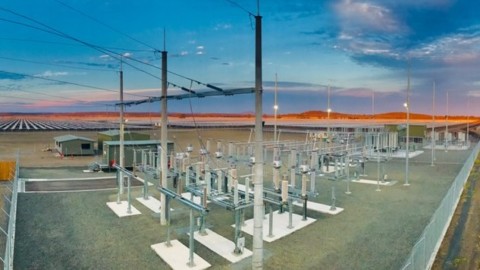The 2022 flood events across the North Coast of New South Wales broke the record books. Labelled a ‘one–in-1,000-year’ event, unprecedented amounts of rain caused major flooding and widespread devastation, leading to much of northern New South Wales and southern Queensland being declared Natural Disaster Zones. Essential Energy, the state-owned electricity infrastructure company for New South Wales, has been front-and-centre throughout the disaster, sharing some unique insights on restoring and maintaining power and, importantly, keeping workers and the community safe.
Tragically, lives were lost, and thousands of houses and businesses were significantly damaged or destroyed. Essential Energy’s Lismore and Murwillumbah depots were flooded, with the Lismore depot completely submerged. Electrical infrastructure across many towns in the Northern Rivers was also submerged, including the Lismore South Zone Substation and Lismore CBD.
Essential Energy said that a number of local employees lost homes or experienced significant damage to their or loved ones’ property, and as the business supported these people, their eagerness to assist with its response was a testament to the strong and resilient community across the area.
The flooding impacted customers from Tweed Heads in the north through to Coffs Harbour in the south. Essential Energy enacted its emergency response plan and prepared for a safe, steady and sustainable response.
The early days
As communities dealt with the muddy aftermath of extraordinary rainfall, and floodwaters continued to move downstream, impacting more communities, Essential Energy utilised helicopters to get a bird’s eye view of the damage to the electricity network. Damage was widespread with trees over powerlines, significant landslips, poles washed away, and electrical assets completely immersed in water.
Essential Energy Head of Operations, Brendon Neyland, said the immediate focus was on making the network safe, assessing damage, mobilising team members and making repairs to the electrical infrastructure where it was safe to do so.
“The safety of our teams and customers was our priority. This included de-energising the network as water levels increased while warning customers to remain vigilant when boating in floodwaters, and not enter properties that had been affected by floodwaters without knowing the power was disconnected,” Mr Neyland said.
“There was also a strong focus on solar panel safety and the need to take additional care due to systems being able to generate an electrical current regardless of whether the power is on or not.”
Understanding many customers were without internet for extended periods, Essential Energy placed electronic road signboards around the community with specific information to assist customers.
It also developed hard copy fact sheets and hand-distributed them throughout the flood recovery area – to evacuation centers, and recovery hubs. The fact sheets covered a range of information, from safe generator use to cleaning up with excavators and bobcats, Look Up and Live, to staying away from fallen powerlines.
Safety was key and as part of the response, Essential Energy disconnected 7,000 water inundated properties from the network. “When a property is inundated by water, it needs to be checked for safety by an electrician before it can be reconnected,” Mr Neyland said.
“Our team developed a simple three-step process to assist customers with getting their power back on. As of last month over 4,600 properties had completed the check and been reconnected.”
Teams from across the state mobilised to start clearing significant debris, trees, and even in one case, a washing machine, from Essential Energy’s assets. The company’s whole-of-business response included 210 local employees and 215 travelling crew members from 30 locations across New South Wales.
It’s standard procedure for Essential Energy to conduct digital Hazard Identification Risk Assessment Controls (HIRACS) before commencing operational work, which were needed in bulk in this case.
“2,215 HIRACs were completed during the response and teams were supported on the ground by our safety business partners who also played a key role in ensuring the community was kept well-informed of risks,” Mr Neyland said.
The road to recovery
Essential Energy logistic and fleet teams delivered supplies into the area including food and water for its teams, new poles, crossarms, cable, fuel, and specialised fleet equipment, boosting local supplies as access became available.
Access remained a key risk throughout the response, with landslips, boggy ground, roads, and bridges washed away. Crews used drones, helicopters, and specialised fleet equipment to access parts of the network, however, this was a slow process.
Helicopters and excavators were also used to restring powerlines and were instrumental in getting the power restored for many rural customers.
The South Lismore Zone Substation suffered significant damage due to complete water inundation. Temporary repairs were made to get the power back on, with temporary switchboards arriving by semi-trailer.
It will take over 12 months to completely repair the zone substation with permanent works to ensure a robust and long-term power supply. The Lismore Uni Switching Station was also partially submerged, damaging secondary systems in the control room on site.
“With support from Engineering and System Control, teams worked to bypass the secondary systems to restore supply to both the Lismore Uni and East Lismore Zone Substations within four days of the water receding, ensuring power for many rural customers and key areas of Lismore,” Mr Neyland said.
The Lismore CBD was a key focus area for Essential Energy, with the entire underground network underwater for days. “Every asset needed to be checked, tested, repaired or replaced. This also had to be repeated across the overhead network, which is unique in the Lismore CBD as it is positioned under building awnings and required specialist teams to undertake the work,” Mr Neyland said.
More than 50 padmount, chamber stations, switching units and cabinets were tested, repaired, or replaced along with 98 underawning main boxes and cubicles. 348 fleet vehicles were used over the response and more than 50,000L of fuel was consumed.
Despite the devastation and heartache for many, Essential Energy said community and local volunteer organisations were instrumental in their support by providing storage for electrical equipment for repairs, accommodation, and food provisions for the team on the ground.
“One incredible act of community spirit saw residents of Upper Wilsons Creek digging a hole for a new pole themselves, which was delivered by helicopter alongside crews to allow repairs to be made,” Mr Neyland said.
Flooded for a second time
“As our teams made repairs and power was slowly being restored across impacted areas, the community was flooded for a second time,” Mr Neyland said.
“This flood, although not as high as the initial flood, still broke previous records and again devastated the area, with clean up and repairs needing to start over for many.
“Despite this set back, our work continued and power restoration maintained momentum as we worked through the challenges while keeping our communities and teams safe.”
In total, 69,603 individual customers were affected by a power outage during the two events.
An empowered future
With over seven weeks of a safe, steady and sustainable response, Essential Energy said the electricity network was fully available for customers to reconnect just before the Easter Long weekend.
While there will still be work to be done at its Zone Substation sites across Lismore, Essential Energy said it would continue to provide significant support as customers were rebuilding and reconnecting to the network.
Essential Energy has now turned its attention to lessons learned and adaptive planning to build a more resilient network to withstand the increase of network events on its assets, while ensuring a safe and reliable supply for its 880,000 plus customers across regional and rural New South Wales and southern parts of Queensland.
”I want to personally thank our customers and the organisations across the flood-impacted areas of northern New South Wales for their ongoing patience, support and assistance on the ground,” Mr Neyland said.


















